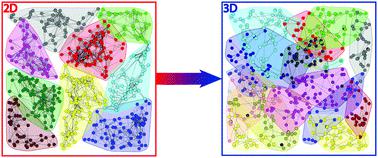当前位置:
X-MOL 学术
›
Nanoscale Horiz.
›
论文详情
Our official English website, www.x-mol.net, welcomes your feedback! (Note: you will need to create a separate account there.)
Nanowire networks: how does small-world character evolve with dimensionality?
Nanoscale Horizons ( IF 9.7 ) Pub Date : 2021-5-6 , DOI: 10.1039/d0nh00693a Ryan K. Daniels 1, 2, 3, 4, 5 , Simon A. Brown 1, 2, 3, 4, 5
Nanoscale Horizons ( IF 9.7 ) Pub Date : 2021-5-6 , DOI: 10.1039/d0nh00693a Ryan K. Daniels 1, 2, 3, 4, 5 , Simon A. Brown 1, 2, 3, 4, 5
Affiliation

|
Networks of nanowires are currently under consideration for a wide range of electronic and optoelectronic applications. Nanowire devices are usually made by sequential deposition, which inevitably leads to stacking of the wires on top of one another. Here we demonstrate the effect of stacking on the topology of the resulting networks. We compare perfectly 2D networks with quasi-3D networks, and compare both nanowire networks to the corresponding Watts Strogatz networks, which are standard benchmark systems. By investigating quantities such as clustering, path length, modularity, and small world propensity we show that the connectivity of the quasi-3D networks is significantly different to that of the 2D networks, a result which may have important implications for applications of nanowire networks.
中文翻译:

纳米线网络:小世界角色如何随着维度发展?
目前正在考虑将纳米线的网络用于广泛的电子和光电应用。纳米线器件通常通过顺序沉积制成,这不可避免地导致导线彼此堆叠。在这里,我们演示了堆叠对生成的网络拓扑的影响。我们将完美的2D网络与准3D网络进行比较,并将这两个纳米线网络与相应的Watts Strogatz网络(标准基准测试系统)进行比较。通过研究诸如簇,路径长度,模块性和小世界倾向性之类的数量,我们表明准3D网络的连通性与2D网络的连通性显着不同,其结果可能对纳米线网络的应用产生重要影响。
更新日期:2021-05-13
中文翻译:

纳米线网络:小世界角色如何随着维度发展?
目前正在考虑将纳米线的网络用于广泛的电子和光电应用。纳米线器件通常通过顺序沉积制成,这不可避免地导致导线彼此堆叠。在这里,我们演示了堆叠对生成的网络拓扑的影响。我们将完美的2D网络与准3D网络进行比较,并将这两个纳米线网络与相应的Watts Strogatz网络(标准基准测试系统)进行比较。通过研究诸如簇,路径长度,模块性和小世界倾向性之类的数量,我们表明准3D网络的连通性与2D网络的连通性显着不同,其结果可能对纳米线网络的应用产生重要影响。

























 京公网安备 11010802027423号
京公网安备 11010802027423号